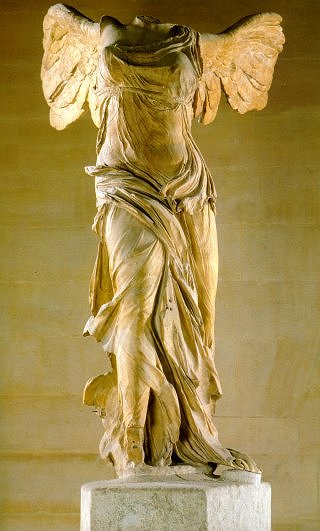49 Romanticism

Romanticism: Liberty Leading the People
This painting was made in response to the political upheaval that resulted in the overthrow of the reigning monarch, Charles X (brother of the beheaded Louis XVI). Charles X had restored the Bourbon throne after the fall of Napoleon and would himself be replaced by the restricted constitutional rule of Louis-Phillipe, the “citizen-king.”
Delacroix’s is a complex painting, full of historical reference, yet also full of the spectrum of human emotion—from grand heroism to angry despair—that is a central characteristic of French Romanticism. Romanticism is usually NOT about love and romance in the common sense of the word. It was named for medieval romance stories of Europe; stories that often included dramatic and emotional moments. Note also in the painting also the complex interaction between areas that are brightly reflective and adjacent areas of dark shadow. The results are vivid contrasts which, like the rapid-fire brushwork, activates the surface and augments the painting’s sense of movement and energy, also frequent characteristics of Romantic painting. Delacroix also breaks with the tradition of relying upon the painstakingly subtle modulation of color, and instead, applies brilliant and shocking traces of pure pigment. See, for example, the notes of sharp primary colors, the blues, yellows and the especially powerful reds. Again, the effect is vivid and electrifying against the broad areas of brown and gray and this fits well with the subject. Liberty rushes forward over the debris of the barricades, by then a signifier of Parisian rebellion.
A Modern Nike
Prior to the late 19th century, the streets of this largely medieval city were the chaotic result of organic unplanned growth. Paris was a warren of tangled streets, some little more than narrow alleys that slowed travel, trade and troops, and could be easily blocked allowing revolutionaries to fortify entire sections of the city. It is upon these very barricades that Liberty, the personification of freedom (who the French call Marianne) stands. She holds the tri-color aloft. This was the banned flag of revolution and democracy.

The wind spins her drapery around her hips alluding to classical statuary. Note that the spiraling costume of the great Hellenistic (late ancient Greek) sculpture, the Nike (victory) of Samothrace on view in the Musée de Louvre was found after the Delacroix was created but is a useful reference nevertheless. For what possible reason has Delacroix exposed Marianne’s breasts? The answer lies in the figure not being an actual person but rather the embodiment of an idea in a human figure. Marianne is, of course, democracy. Democracy was born in Ancient Greece as Delacroix reminds us by his reference to ancient sculpture and his use of partial nudity. But there is a second reference here. During France’s first revolution, the one that began in 1789, the newly created democratic state was sometimes depicted as an infant suckled by freedom, by Marianne, its mother.
Class Distinctions
Beside Marianne, we see a menacing crowd that dissolves into the smoke and the confusion of battle. But in the left middle ground, Delacroix depicts two figures with greater clarity. They stand together but represent very different social and economic positions. The man in the top hat, waistcoat and jacket is a member of the middle class. The second figure is less well off. He wears a white shirt and cap and is meant to represent a laborer, a member of the working or lower class. Delacroix’s message is clear. The revolution unites these classes against the ruling aristocracy.
The Cost of Rebellion
In the foreground lay two dead bodies. The figure on the left is intended to enrage the viewer. To set the viewer firmly against the excesses of the king’s troops. In this sense the painting is pure propaganda. The dead figure on the left is dressed in a long nightshirt that has been push up as his body was dragged into the street from his bedroom where, presumably, he had been shot. Delacroix is alluding to the despised practice of the royal troops who spread terror by murdering suspected revolutionary sympathizers in their beds and then dragging the bodies into the streets as a warning. The dead uniformed figure on the right is a royalist soldier. Here, Delacroix shows the enemy as vulnerable. If you look carefully at the buildings at the right you will see the battle joined and in the distance, the great Gothic cathedral, Notre Dame de Paris, a symbol of the King’s power but which is now triumphantly flying the tricolor.

